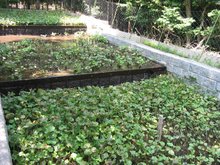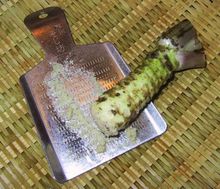Wasabi
2007 Schools Wikipedia Selection. Related subjects: Plants
| iWasabi | ||||||||||||||
|---|---|---|---|---|---|---|---|---|---|---|---|---|---|---|
 Wasabi crop growing on Japan's Izu peninsula
|
||||||||||||||
| Scientific classification | ||||||||||||||
|
||||||||||||||
|
|
||||||||||||||
| Wasabia japonica Matsum. |
Wasabi ( Japanese: ワサビ, 山葵 (originally written 和佐比) ; Wasabia japonica, Cochlearia wasabi, or Eutrema japonica) is a member of the cabbage family. Known as Japanese horseradish, its root is used as a spice and has an extremely strong flavour. Its hotness is more akin to that of a hot mustard than a chili pepper, producing vapors that burn the nasal passages rather than the tongue. The plant grows naturally along stream beds in mountain river valleys in Japan. There are also other species used, such as W. koreana, and W. tetsuigi. The two main cultivars in the marketplace are W. japonica var. Duruma and Mazuma, but there are many others.
Uses
Wasabi is generally sold either in the form of a root, which must be very finely grated before use, or as a ready-to-use paste, usually in tubes approximately the size and shape of travel toothpaste tubes. Once the paste is prepared it should remain covered until served to protect the flavor from evaporation. For this reason, sushi chefs usually put the wasabi between the fish and the rice.
Fresh leaves of wasabi can also be eaten and have some of the hot flavor of wasabi roots. They can be eaten as wasabi salad by pickling overnight with a salt and vinegar based dressing, or by quickly boiling them with a little soy sauce. Additionally, the leaves can be battered and deep-fried into chips.
Fortunately for those who mistakenly consume too much of this condiment, the burning sensations it can induce are short-lived compared to the effects of chili peppers, especially when water is used to dissipate the flavor. Wasabi paste bears a superficial resemblance to guacamole, a popular staple of Mexican-style cuisine, a similarity which can lead to an unpleasant surprise for those unfamiliar with Japanese cuisine.
Wasabi is often served with sushi or sashimi, usually accompanied with soy sauce. The two are sometimes mixed to form a single dipping sauce known as Wasabi-joyu. Wasabi peas and peanuts are growing in popularity, most notably in the United States. These legumes are roasted or fried, then coated with a wasabi-like mixture (usually an imitation). These are then eaten as an eye-watering "in the hand" snack.
Wasabi-like flavoring is also used in Frito-Lay's Funyuns.
Wasabi and imitations
Almost all sushi bars in America, and most in Japan, serve imitation (seiyō) wasabi (see Etymology section, below) because the real product is relatively more expensive. True wasabi is made from the wasabi plant but wasabi is also made from horseradish, mustard seed, and green food coloring (sometimes spirulina), often as a powder to be mixed with water to make a paste. Since real wasabi loses its flavor if dried, its presence as an ingredient in some powders is of questionable value. To distinguish between the true variety of wasabi and the imitation product, real wasabi is known in Japan as hon-wasabi (本山葵), meaning original, or true wasabi.
Chemistry
The chemicals in wasabi that provide its unique flavor are the isothiocyanates, including:
- 6-methylthiohexyl isothiocyanate,
- 7-methylthioheptyl isothiocyanate and
- 8-methylthiooctyl isothiocyanate.
Research has shown that isothiocyanates have beneficial effects such as inhibiting microbe growth. This may partially explain why wasabi is traditionally served with seafood, which spoils quickly. However, if the quality of one's seafood is questionable, one should not eat it raw, with or without wasabi. It is not a treatment for food poisoning.
Cultivation
Since few places are suitable for large-scale wasabi cultivation, and because such cultivation is difficult even in ideal conditions, most of the "wasabi" served today is really just European horseradish dyed green, or a mix of horseradish with black mustard and chlorophyll for the same effect. In Japan, wasabi is cultivated mainly in these regions:
- Izu peninsula
- Nagano prefecture
- Shimane prefecture
- Yamanashi prefecture
- Iwate prefecture
There are also numerous artificially cultivated facilities as far north as Hokkaidō and as far south as Kyūshū. The demand for real wasabi is very high. Japan has to import a large amount of it from:
- Mainland China and
- Ali Mountain of Taiwan
- Oregon, United States
- New Zealand.
Without proper regulation, wasabi cultivation can be a major pollutant to rivers as it usually requires fertilizer such as chicken manure and constantly flowing water.
Preparation
Wasabi is often grated with a metal oroshigane, but some prefer to use a more traditional tool made of dried sharkskin (鮫皮) with fine skin on one side and coarse skin on the other. A hand-made grater with irregular teeth can also be used. Because fresh wasabi can be rather costly many restaurants prefer to use a powder mix substitute.
Etymology
The two kanji characters "山" and "葵" do not correspond to their pronunciation: as such it is an example of gikun. The two characters actually refer to the mountain hollyhock, as the plant's leaves resemble those of a member of the Malvaceae family, in addition to its ability to grow on shady hillsides. The word, in the form 和佐比, first appeared in 918 in The Japanese Names of Medical Herbs (本草和名 Honzō Wamyō). Spelled in this way, the particular kanji are used for their phonetic values only.
In Japanese, horseradish is known as seiyō wasabi (西洋ワサビ ?), or "Western wasabi".
In popular culture
- Wasabi has inspired a song, "Wasabi Kiss" ("山葵KISS!"), by Belgo-Japanese-Vietnamese music project Awaken.
- The line "Hot like Wasabi" was used in the Barenaked Ladies song "One Week."
- Australian Idol contestant, Lee Harding's first CD single was titled " Wasabi/Eye of the Tiger" and hit #1 in Australia in 2005
- In Jackass: The Movie, one of Steve-O's stunts was to snort wasabi, which resulted in vomiting.
- Indie group Cibo Matto has a song entitled " Sci-Fi Wasabi."
- Wasabi is a 2001 French movie produced by Luc Besson and starring Jean Reno.
- Budweiser beer ran a series of advertisements where their slogan "Whazzzzzup" was met with a "Wasabi" in reply.
That commercial had a small explosion among schools and teens using the word with double Ses instead of implying the food, meaning "What's up?". I.E. Wassabi!
- Wasabi was also referred to in Lemony Snicket's eleventh book " The Grim Grotto" in " A Series of Unfortunate Events". It was used to dilute a powerful poison afflicting Sunny Baudelaire. Wasabi is also mentioned in the same context in The End.
- In Good Omens by Neil Gaiman and Terry Pratchett, Newt drives a small Japanese car called a Wasabi.
- In November 2005, in Alhambra, California, a dog breeder, whose golden retriever had given birth to a puppy with green fur, named the puppy "Wasabi" in honour of the plant ( http://www.local6.com/news/5290491/detail.html).


